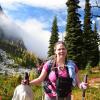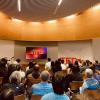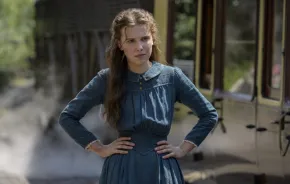 If you’ve followed my blog for long, you’ll know that we love birds in this family, and we love field guides of all kinds. So when I first saw A Kid’s Guide to Birding, by Lorenzo and Michael Rohani, I didn’t think it would have much that was different to offer us. But I was happily wrong!
If you’ve followed my blog for long, you’ll know that we love birds in this family, and we love field guides of all kinds. So when I first saw A Kid’s Guide to Birding, by Lorenzo and Michael Rohani, I didn’t think it would have much that was different to offer us. But I was happily wrong!
This slim guide is not so much a field guide (though local birders will find plenty of familiar birds) as it is a general but thorough how-to book for those who wish to learn more about this enjoyable hobby. It is written in a style that will be accessible to children, yet is serious and professional in tone. A Kid’s Guide to Birding is full of tips for making your birding experience more fruitful, from what to look for when identifying a new bird to tools for birding, such as binoculars and field guides.
The best thing about A Kid’s Guide to Birding, though, is Lorenzo Rohani’s photographs. This young photographer has managed to record birds in all sorts of environments and in various poses and activities. I was amazed to see the level of detail he was able to capture, the interesting and sometimes humorous expressions of the birds, and the close-up looks at some of our most beloved birds. Lorenzo has won awards for his photography, and I think you’ll enjoy thumbing through this book just to see his pictures.
Lorenzo and Michael gave a presentation and led a bird walk at the recent Puget Sound Bird Fest. Below is an interview they did for my blog, thehikermama.com. I start with Lorenzo, then Michael.
How old are you now? What grade are you in this year?
Lorenzo Rohani: I’m now 13 and I’m in 7th grade.
How old were you when you started birding? Was anyone in your family teaching you about birds, or was it something that you became interested in on your own?
LR: I started birding when I was five and gave my first presentation about birds to my kindergarten class. My dad talked to me about birds and conservation. He also got me a field guide so I could start learning about bird identification on my own.
Many birders talk about a “spark bird,” a bird that kindled their interest in birding in the beginning. Do you have a spark bird that you can remember?
LR: My dad says that a Black Scoter was the bird that started our conversations about birds, but what I recall most was that he took me to the Puget Sound Bird Fest in Edmonds. We went together many years and that was always interesting. He also took me to Skagit valley to see the migrations of Swans and Geese and the many raptors that come there. In the beginning, the birds in my area that I really found interesting were blue herons, belted kingfishers, hummingbirds, Pileated woodpeckers, ospreys and other raptors.
Have you had any funny or frightening experiences with birds?
LR: There have been times when we were hiking and have had hawks taking dives at us. This has happened twice on the Umtanum trail with Northern Harriers. We were on the main trail and didn’t know that we were near a nest. Recently I was out in England trying to photograph recovering Red Kites – a large raptor. There were about 17 of them flying low over an open field, then suddenly about six were flying low over me and I was wondering if I was in trouble. Fortunately they were just curious.
Where are your favorite places to go birding?
LR: My backyard garden is actually a great place to bird. I have documented 42 species, including Cooper’s hawks and Pileated woodpeckers. Locally, the Edmonds Marsh and waterfront, and Juanita Bay Park (Kirkland) are great birding locations. In fact, there are many parks around Seattle that are great birding locations. But when I get a chance I really like going out to the Columbia basin area, especially the Columbia National Wildlife Refuge, which has lots of hawks, Shrikes, Sandhill Cranes, and other interesting birds.
I understand that you use your Dad’s cameras for your photography. How did you learn how to use such technical cameras at a young age? Do you have any good resources to share for other kids who are interested in photography?
My dad showed me the basics and I have learned the rest by trial and error. I have also gotten some good tips from other wildlife photographers I have met when out birding. I think the main things you need to know to do good bird photography are not so much technical. What matters more is patience and an ability to anticipate what the bird will likely do next.
What are some of the biggest challenges to photographing birds?
LR: The biggest challenges are finding birds and having sufficient lighting to get a good photo, which is hard here in the Northwest because there are so many cloudy days. Many birds like to keep moving, so it is really hard to get a photo that isn’t blurry when the light is low.
In the book you talk about your garden having many native plants to help attract birds. Do you have a favorite native plant for attracting birds to your yard?
LR: So far I have documented Robins eating the Salal berries and House Finches eating the Red Huckleberries. We plan to add Red Columbine soon, which I think the hummingbirds will like. Our garden is small, but it has everything that birds like – sources of water, native berries, insects, and plenty of cover as well as good limbs for perching on. We try to keep it natural.
How did you come up with the idea to write a book?
LR: The book idea was my dad’s idea. He liked my photos and once I had so many photos of so many different species of birds from so many habitats–mountains, deserts, the ocean, scrublands, forests, wetlands, coastline –he thought we should make a book. And, as we finished the book, I got an amazing opportunity to photograph the snowy owls, so those got to be included in the book. One of the Snowy Owl photos won the TIME for Kids national Earth Day photo contest.
(Next up is Lorenzo’s Dad, Michael Rohani.)
Were you interested in birding before Lorenzo, or did he draw you into it by his curiosity?
Michael Rohani: My mom was a birder and I like wildlife and hiking but never took birding that serious, nor found many opportunities to get out and hike, so I think it is fair to say Lorenzo drew me into it. So far, no one else in the family has gotten very interested in birding, but they do come along on some of our trips. The more one learns about birds the more interesting they become and many of the birds are beautiful to see and hear, so it is not that hard to get interested.
Tell me about how you trained Lorenzo to use your cameras, and how you got to the point where you could trust him with such expensive equipment.
MR: I only showed Lorenzo the basic functions of the camera and the manual that came with the camera. Beyond that it has been up to him to build up his skills. Trusting him with the equipment has been tough. In the beginning it was a less expensive camera, but I eventually upgraded the camera and the lenses, so that increased the concern. The toughest decision was letting him get on a plane by himself with the camera equipment at age 12 and head off to the Rocky Mountains for a summer birding camp. Thankfully both he and the camera equipment survived. Ultimately, you have to take some risks. If a kid has a special interest at an early age, even if it doesn’t last, it provides you with an opportunity to help him or her discover things about life and themselves. Opportunities like that – like his birding – can become something worthwhile and worth some risks.
Who comes up with ideas for the birding trips you take? How many outings do you make in an average month? Do you ever take time away from school to go birding?
MR: Lorenzo often indicates where he wants to go birding and I’m okay with that. Locations are often determined because of a species we haven’t seen or because he wants to get a better photo of it. Sometimes we don’t find much and other times we find a lot, but usually, the habitat itself is a beautiful place, so the trip is worth it. I’ve never tried to quantify our birding trips, but sometimes it is everyday and other times maybe only once or twice in a month. It depends a lot on the weather, some on the season for the birds, and some on the soccer schedule. I have only pulled him out of school once for a birding trip and that was because of a short break in the rainy weather that provided a rare opportunity to photograph snowy owls in Canada. That trip was great fun and a great success.
I love seeing kids being able to take a passion as far as they can with their parents along for the ride. Do you have any advice for parents who have children interested in birding or photography?
MR: I think if you have a kid interested in something, such as birding, don’t make age a barrier for them. Kids are often more capable than we imagine. It may require some risks and a lot of supervision in the beginning, but think of it as quality time together. When I look at his photographs or his book, A Kid’s Guide to Birding, I see more than just the birds, I see a series of fun adventures to find those birds spanning three years of our time together. I can’t think of anything else that we could have done together that would have been better. Whatever happens we will always have that.
If you are interested in this book, check out their website, www.kidsbirding.com, for ordering information, or pick it up locally at the Edmonds Book Shop. The list price is $16.95. Lorenzo and Michael are also available to come speak to your group or school. See also my write-up of fall birding activities.
 Jennifer Johnson looks for any excuse to escape into nature with her children. She blogs about hiking with children at thehikermama.com, where this article originally appeared.
Jennifer Johnson looks for any excuse to escape into nature with her children. She blogs about hiking with children at thehikermama.com, where this article originally appeared.












